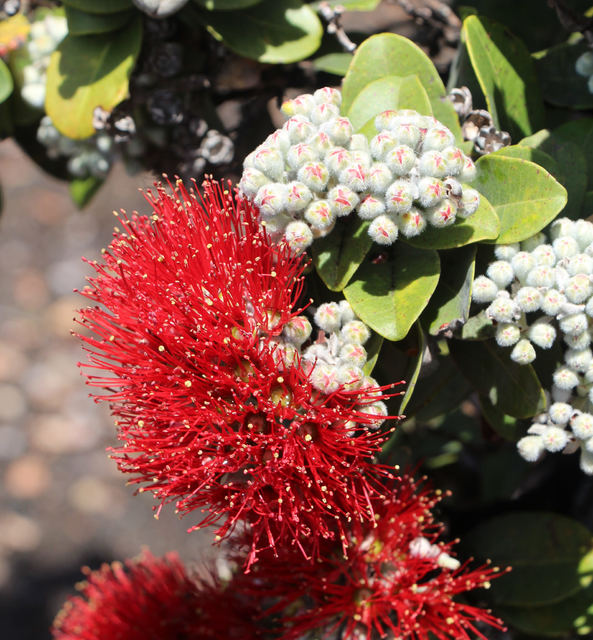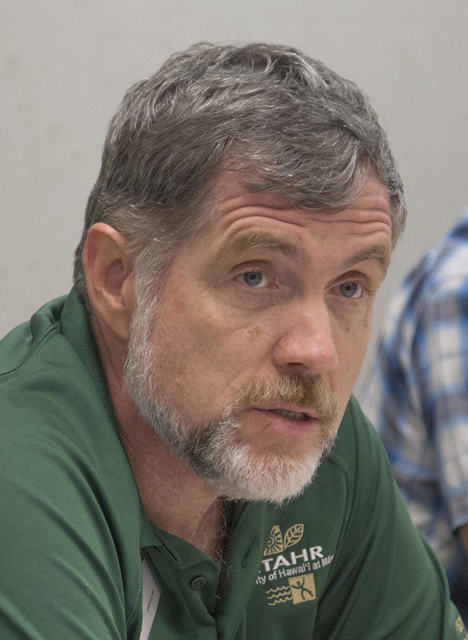HILO — Since its discovery in 2010, rapid ohia death has devastated thousands of acres of native forests throughout Hawaii Island.
HILO — Since its discovery in 2010, rapid ohia death has devastated thousands of acres of native forests throughout Hawaii Island.
But the disease has not been found anywhere else in the state.
The spread of the fungus that causes rapid ohia death, Ceratocystis fimbriata, has been contained in part because of an emergency quarantine rule put into effect last summer by the state Board of Agriculture. The rule, which went into effect in August 2015, prohibited transport of ohia from the Big Island.
On Tuesday during its regular monthly meeting, the board begins the process of making that rule permanent. Members are scheduled to vote on preliminary approval of amendments to Hawaii’s plant intrastate rules, adding a new section specific to the ohia quarantine.
The proposal in question would “designate the island of Hawaii as a Rapid Ohia Death infested area,” according to the BOA agenda. Transporting ohia “flowers, leaves, seeds, stems, twigs, cuttings, wood, logs, mulch, green waste, frass and soil” from the Big Island would be prohibited except for cases where the Department of Agriculture issues a permit.
Green waste and mulch were not part of the emergency quarantine.
J.B. Friday, extension forester with the University of Hawaii College of Tropical Agriculture and Human Resources, said the quarantine had been an effective tool for slowing rapid ohia death’s spread, particularly relating to the transport of ohia wood.
Ohia posts and poles often are used as construction materials.
“In terms of the likelihood of something moving the disease, wood is really it because this fungus is in the sapwood,” Friday said. “That’s a really risky thing to move.”
Rapid ohia death was first observed in Puna in 2010. Aerial mapping conducted by the state Department of Land and Natural Resources showed the disease has affected more than 38,000 acres of ohia trees in the southern regions of the island. Some stands in lower Puna have shown more than 90 percent mortality.
The emergency yearlong quarantine rule gave “agencies time to determine possible needs,” said Christy Martin, public information officer for the Oahu-based Coordinating Group on Alien and Pest Species.
Public outreach has been a key component in the fight against the disease.
“The issue is serious, so it’s really easy to get that message across,” Martin said. “The other thing is we have a lot of groups working … who already have their audience, and (are) utilitizing exisiting networks to get the word out.”
Those groups include the DLNR Division of Forestry and Wildlife and the islands’ invasive species committees and watershed partnerships.
Forestry and Wildlife employees on Maui and in Hilo worked to create signs notifying hunters and hikers of protocol for keeping boots and gear decontaminated when they go out into the forest.
Though Ceratocystis fimbriata was positively identified as the cause of rapid ohia death in 2014, there are still plenty of unknowns. Nobody knows, for example, how long a tree can have an infestation of Ceratocystis fimbriata before it begins to exhibit symptoms. But once it does start showing symptoms, such as the yellowing of leaves, a tree will die in a matter of weeks.
“I liken it to a heart attack,” Friday said. “Someone might have been building up plaque in his arteries for years (before).”
Other research seeks to determine what types of insects might be vectors for the disease and what types of treatment could be effective.
Rapid ohia death has not been found in all parts of the Big Island: North Hilo, Hamakua and Kohala have not yet had any trees struck by the disease.
The proposed quarantine does not affect interisland transport, making the role of public education even more crucial.
“It’s going to be too hard to regulate someone cutting firewood and (transporting) it, ” Friday said. “We’re trying to educate people not to do that.”



